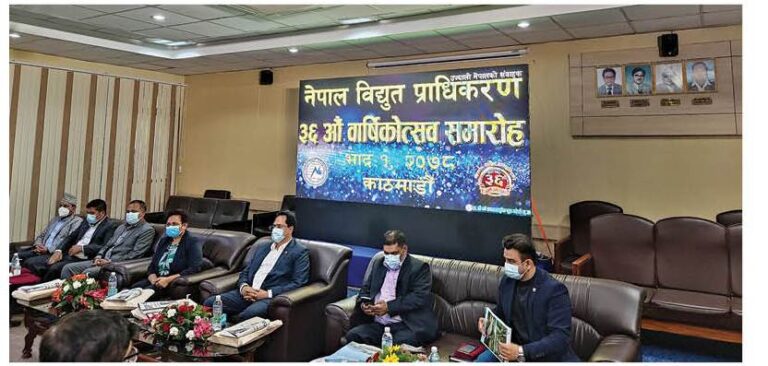
Minister for Energy, Water Resources and Irrigation Pampha Bhusal has directed the Nepal Electricity Authority (NEA) to make a strategic plan to achieve the goal of fully electrifying the country as early as possible in the next two years.
“The authority should work with an action plan to fully electrify the country as per the government target of 2080 BS,” she said while addressing the 36th anniversary of the NEA Tuesday.
She said that the government was going to implement varying electricity consumer tariffs to increase consumption within the country.
She said that action plan to increase internal consumption should be implemented effectively considering the situation of wastage of electricity in the coming rainy season.
“In order to increase domestic consumption, it has been decided to fix different electricity tariffs for rainy season and dry season. It is important to adjust,” she said.
“As a result, foreign capital is reserved in Nepal for gas purchase. On the other hand, if consumers can consume electricity cheaply, consumption will increase and wasted electricity will be used in the near future,” she said. “My priority is to electrify agriculture by installing irrigation feeders on cultivable land and to provide electricity for irrigation at concessional rates.”
Secretary at the Ministry of Energy, Water Resources and Irrigation Devendra Karki said that the ministry was ready to provide any assistance to strengthen the capacity of NEA to improve the power supply.
Managing director of NEA Kul Man Ghising committed to provide effective service to the customers by reducing the operating cost through the use of automated system in monitoring, control and management of the system from power generation to distribution.
Stating that the distribution system needs to be expanded and strengthened along with the increase in electricity demand and consumption, Ghising informed that such works would also be taken forward with priority.
“Market management is challenging for the sale of electricity generated from projects, including the Upper Tamakoshi Hydropower Project. Necessary arrangements will be made to consume the produced electricity in the country and sell the surplus electricity in the inland market,” he said.
NEA’s profit declines by 69.94%
NEA has earned a net profit of Rs. 3.51 billion in the last fiscal year 2020/21 which is 69.94 per cent lower than the profit of the previous fiscal year, said Ghising.
In the fiscal year 2019/20, the NEA earned net profit of Rs. 11.68 billion.
The revenue from electricity sales of the NEA has declined by 6.59 per cent last year. NEA has earned Rs. 71.28 billion from the sale of electricity in the last fiscal year while it was Rs. 76.31 billion in the previous fiscal year 2019/20.
Ghising said that power leakage and profit have been affected in the last fiscal year due to COVID-19 pandemic.
He said that the leakage has increased as the regular meter reading and power leakage control work has been affected due to the prohibitory order.
Electricity leakage up by about 2%
Electricity leakage of NEA has increased by about 1.91 per cent in last fiscal year compared to previous fiscal year. Electricity leakage reached 17.18 per cent in the last fiscal year while it was only 15.27 per cent in the fiscal year 2019/20.
Leakage was reduced to 22.9 per cent in 2016/17, 20.45 per cent in 2017/18 and 15.32 per cent in 2018/19.
In the last fiscal year, the total leakage of the system was planned to be reduced to 13.50 per cent. However, it did not succeed.
90% population connected to national grid
Overall, 90 per cent of the country’s population has so far received basic electricity with access to the grid.
The number of consumers using electricity has increased by 7.35 per cent in the last fiscal year compared to the previous fiscal year.
The total number of clients consuming electricity has reached 5.08 million at present.
NEA has succeeded in substantial electrification in 32 districts by fiscal year 2020/21 despite the COVID-19 pandemic. Electricity has also been supplied to Kalikot and Jumla in Karnali from the national transmission system
NEA’s production declines, import from India increases
Electricity production from projects operated by NEA has decreased in the last fiscal year.
Electricity import from India increased by 63.45 per cent last year due to reduction in power generation from its projects, said NEA.
About 2.82 billion units of electricity was imported from India during the last fiscal year 2020/21 while only 1.73 billion units of electricity was imported from India in the previous fiscal year, said Ghising.
The power houses of the NEA produced only 2.81 billion units in last fiscal year which is 6.96 per cent lower than the previous fiscal year.
About 3.2 billion units were produced from the power houses of NEA in the fiscal year 2019/20.
Ghising informed that the production of electricity from NEA projects decreased by 210 million units last year as compared to the previous year.
However, power generation from the private sector’s projects increased in the last fiscal year. Last year, production from private investment projects increased by 8.36 per cent to 3.24 billion units.
Only 2.99 billion units were received in the corresponding period of the previous year.
According to NEA, about 8.87 billion units of electricity was made available in the system last year while only 7.14 billion units were available in the previous year. This amount is 14.86 per cent higher compared to the previous year.
Out of the total energy supply, the share of NEA is 31.66 per cent, electricity imported from India 31.83 per cent and that of private sector is 36.51 per cent.
Source : TRN,





